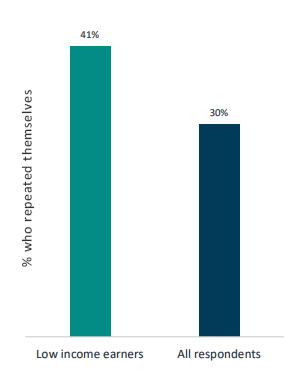This section explores how people earning different incomes experience Australian public services.
A focus is placed on people earning a low household income of $20,799 or less per year.
Who did we survey?
- $156,000+: 10%
- $91,000 - $155,999: 23%
- $65,000 - $90,999: 18%
- $41,600 - $64,999: 20%
- $20,800 - $41,599: 21%
- $20,799 or less: 8%
Low income earners have frequent service interactions and find them difficult to navigate
Frequent and complex
Low income earners have frequent and complex service interactions. They have more reasons to engage with services, access multiple services for the same reason and use multiple channels.
Low expectations
Low income earners are more likely to have low expectations, less satisfaction and higher distrust.
Feedback
Low income earners are more likely to provide feedback and agree Australian public services need to change.
Low income earners have frequent service interactions and find them difficult to navigate.
Frequent interactions
While most respondents had a reason to access one or more public services in the last 12 months, low income earners are more likely than other cohorts to have three or more reasons to access services (42%).
Complex reasons
The most common reasons low income earners have for accessing services are looking for work (38%), submitting a personal tax return (33%) and unemployment (27%).
Low income earners are more likely to access services for disability (16%) or chronic health conditions (21%).
In contrast, high income earners access services to submit a personal tax return (68%), travel overseas (27%) and undertake or update registrations (20%).
Multiple services
For each reason most people primarily access one service (33%-42%). Low income earners are more likely to access three or more services for the same reason (19%) than other cohorts (13%-16%).
Low income earners were more likely to report significant effort to access and receive services (36%) than other cohorts (28%-32%). Where low income earners were accessing more than one service, they also report less understanding of what services to access and when to access them.
Across multiple channels
Low income earners are more likely to use three or more channels to access a given service (29%) than other cohorts (16%-23%). Conversely, higher income earners are most likely to use just one channel.
myGov is the most used channel for accessing services across all cohorts (63%-71%). Lower income cohorts are more likely to use phone call and in-person channels, while those with higher incomes were more likely to use APS websites.
Just under a quarter of low income earners report they could not change how they interact with services (23%).
Equally, low income earners report, if it were possible, they would change how they interact with services (23%).
Often the left hand doesn't know what the right hand is doing
Low income earners are more likely to have low expectations, less satisfaction and higher distrust
Lower expectations
Low income earners are more likely to have low expectations of public services (16%) than other cohorts (8%-10%).
Less Satisfaction
Low income earners express less satisfaction with services (42%) than high income earners (54%). Across all satisfaction questions (e.g. being treated with respect, getting what you need) low income earners report the lowest levels of satisfaction with specific services.
Higher Distrust
Low income earners report less trust in public services (27%) than other cohorts (30%-33%) and more distrust (17%, compared to 6%-11% of other cohorts).
Low income earners have lower levels of trust in the fairness, openness and honesty, integrity, reliability and responsiveness of services.
I used to think I could [trust services], but lately I've heard stories that contradict that, so I'm not sure what to think.

Low income earners are more likely to agree Australian public services need to change
More feedback
Low income earners are more likely to provide feedback (24%) than other cohorts (16%-22%). While low income earners are more likely to make a compliment (49%), those with incomes of $20 800 - $41 599 are most likely to make a complaint (35%). Higher income earners are more likely to make a suggestion for change. Lower income earners are more dissatisfied with how their feedback is handled (29%) than other cohorts (14%-25%).
A desire for change but less trust
Low income earners are more likely to agree Australian public services need to change to meet all Australians' needs (44%) than other cohorts (36%-42%). However, they are also more likely to distrust the ability of Australian public services to implement the required changes (17% versus other income cohorts 8%-11%).
